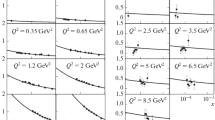Abstract
We consider the process γγ→H1H̄2, where H1 and H2 are either mesons or baryons. The experimental findings for such quantities as the pp̄ and KSKS differential cross sections, in the energy range currently probed, are found often to be in disparity with the scaling behaviour expected from hard constituent scattering. We discuss the long-distance pole–resonance contribution in understanding the origin of these phenomena, as well as the amplitude relations governing the short-distance contribution, which we model as a scaling contribution. When considering the latter, we argue that the difference found for the KSKS and the K+K- integrated cross sections can be attributed to the s-channel isovector component. This corresponds to the ρω→a subprocess in VMD (vector-meson-dominance) language. The ratio of the two cross sections is enhanced by the suppression of the φ component, and it is hence constrained. We give similar constraints to a number of other hadron-pair production channels. After writing down the scaling and pole–resonance contributions respectively, the direct summation of the two contributions is found to reproduce some salient features of the pp̄ and K+K- data.
Similar content being viewed by others
References
Belle Collaboration, C.-C. Kuo et al., Phys. Lett. B 621, 41 (2005) [arXiv:hep-ex/0503006]
C.-C. Kuo, talk at Belle τ/2γ meeting, Nagoya, Japan, 11–12 March 2004
Belle Collaboration, K. Abe et al., Eur. Phys. J. C 32, 323 (2003) [arXiv:hep-ex/0309077]
Belle Collaboration, H. Nakazawa et al., Phys. Lett. B 615, 39 (2005) [arXiv:hep-ex/0412058]
V.A. Matveev, R.M. Muradian, A.N. Tavkhelidze, Lett. Nuovo Cimento 7, 719 (1973)
S.J. Brodsky, G.R. Farrar, Phys. Rev. D 11, 1309 (1975)
VENUS Collaboration, H. Hamasaki et al., Phys. Lett. B 407, 185 (1997)
CLEO Collaboration, M. Artuso et al., Phys. Rev. D 50, 5484 (1994)
L3 Collaboration, P. Achard et al., Phys. Lett. B 571, 11 (2003) [arXiv:hep-ex/0306017]
TPC/Two-Gamma Collaboration, H. Aihara et al., Phys. Rev. Lett. 57, 404 (1986)
ARGUS Collaboration, H. Albrecht et al., Z. Phys. C 48, 183 (1990)
Belle Collaboration, W.T. Chen et al., arXiv:hep-ex/0609042
M. Benayoun, V.L. Chernyak, Nucl. Phys. B 329, 285 (1990)
V.L. Chernyak, Phys. Lett. B 640, 246 (2006)
S.J. Brodsky, G.P. Lepage, Phys. Rev. D 24, 1808 (1981)
See [15] and the listing under 5 therein
M. Diehl, P. Kroll, C. Vogt, Phys. Lett. B 532, 99 (2002) [arXiv:hep-ph/0112274]
M. Diehl, Eur. Phys. J. C 26, 567 (2003) [arXiv:hep-ph/0206288]
See, for example, P.D.B. Collins, An introduction to Regge theory and high energy physics, (Cambridge University Press, 1977)
A. Donnachie, H.G. Dosch, P.V. Landshoff, O. Nachtmann, Pomeron Physics and QCD (Cambridge University Press, Cambridge, 2002)
A. Donnachie, P.V. Landshoff, Nucl. Phys. B 231, 189 (1984)
T. Feldmann, Int. J. Mod. Phys. A 15, 159 (2000) [arXiv:hep-ph/9907491]
Particle Data Group, S. Eidelman et al., Phys. Lett. B 592, 1 (2004)
M.M. Nagels et al., Nucl. Phys. B 147, 189 (1979)
S. Kanwar, R.C. Verma, M.P. Khanna, Prog. Theor. Phys. 62, 1152 (1979)
K. Igi, Phys. Rev. Lett. 9, 76 (1962)
R. Dolen, D. Horn, C. Schmid, Phys. Rev. Lett. 19, 402 (1967)
K. Igi, S. Matsuda, Phys. Rev. Lett. 18, 625 (1967)
A.A. Logunov, L.D. Soloviev, A.N. Tavkhelidze, Phys. Rev. Lett. B 24, 181 (1967)
K. Odagiri, Nucl. Phys. A 748, 168 (2005) [arXiv:hep-ph/0406267]
G. Veneziano, Nuovo Cim. 57, 190 (1968)
J.K. Storrow, Phys. Rep. 103, 317 (1984)
L3 Collaboration, P. Achard et al., Phys. Lett. B 536, 24 (2002) [arXiv:hep-ex/0204025]
CLEO Collaboration, S. Anderson et al., Phys. Rev. D 56, 2485 (1997) [arXiv:hep-ex/9701013]
C.F. Berger, W. Schweiger, Eur. Phys. J. C 28, 249 (2003) [arXiv:hep-ph/0212066]
Author information
Authors and Affiliations
Corresponding author
Additional information
PACS
11.30.Hv; 12.40.-y; 12.40.Nn; 12.40.Vv; 13.66.Bc
Rights and permissions
About this article
Cite this article
Odagiri, K., Verma, R. Flavour structure of low-energy hadron-pair photoproduction. Eur. Phys. J. C 52, 159–171 (2007). https://doi.org/10.1140/epjc/s10052-007-0337-0
Received:
Revised:
Published:
Issue Date:
DOI: https://doi.org/10.1140/epjc/s10052-007-0337-0



